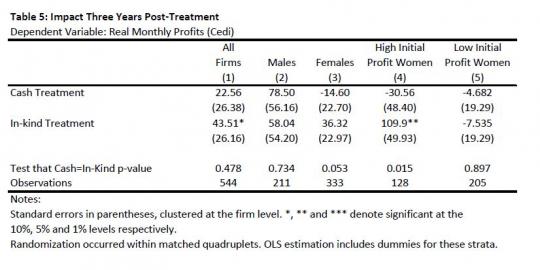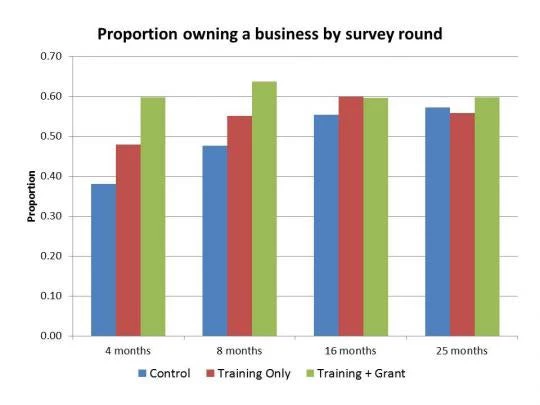There has been a lot of
recent debate and discussion about the role of cash grants in aid, and whether aid is more effective when simply given as unrestricted cash compared to approaches such as conditional transfers which try to restrict how recipients use any money received. Traditionally this debate has centered around food aid and education funding, but more recently this discussion has also arisen with respect to funding small businesses.
Given this debate, I thought it would be useful to note a couple of points from two of my papers that were both recently accepted for the Journal of Development Economics, with the final versions having some new results in one case.
Cash vs Conditions for Small Business Growth over a Longer Horizon
In Ghana, along with Marcel Fafchamps, Simon Quinn, and Chris Woodruff, we gave one-time grants of approximately $120 to a random sample of male and female business owners. Half the grants were given as unrestricted cash, while the other half were given in-kind, with research assistants accompanying the owner to directly purchase something for the business. I blogged about the initial results back in 2011, with the bottom line there being that after 1 year, we found: women who owned subsistence businesses didn’t grow regardless of how they received the money; women with larger businesses to start with had their business grow if they received the grant was received in-kind, but not if it was received in cash; and the results for males were a little messier, with definite growth from the in-kind grants, and less precision on the cash grant effects.
The newly accepted version of the paper discusses these results in terms of a “flypaper effect” – the idea that money sticks where it hits, with some evidence to suggest that mental accounting and self-control issues help explain the difference in how women respond to cash vs in-kind grants. New relative to the working paper is that we conducted a longer-term follow-up survey approximately three years after treatment, and include the results from this longer-term follow-up. Table 5 below shows the longer-term results: pooling by gender, we find a significant impact of the in-kind treatment 3 years later. When we split the sample by gender, we find large, positive, but not statistically significant impacts for males (in the main part of the study we pool together multiple rounds to increase power); and a statistically significant difference in response to the type of grant for women – which is again driven by the women with initially high profits – three years later, those women who initially had high profits and who got the 150 cedi grant in-kind are earning 110 cedi more per month in profits, whereas those who got the grant in the form of cash are, if anything, earning lower profits than the control.

These results therefore provide a data point to argue that “just give them cash” may not be the best way of growing microenterprises, and that ensuring the cash gets into the business can have large payoffs for some groups.
Allowing Time for Effects to Occur
The second paper, with Suresh de Mel and Chris Woodruff, looks at business training for women in Sri Lanka. I don’t think I’ve blogged about this paper before, so here’s the quick run-down (a 2-page impact note also summarizes it).
We work with two groups of women - a group of 628 women running subsistence businesses, and a group of 628 women who are out of the labor force but looking to start new businesses. The former get 400 individuals randomly assigned to the ILO improve your business training program, and the latter 400 individuals randomly assigned to the Start Your Business and Generate Your Business idea program. Half of those who complete the training are then randomly assigned to receive a cash grant of approximately $130. Four follow-up surveys were conducted, at time intervals corresponding to 4, 8, 16 and 25 months after training.
The figure below shows one of the key findings I want to highlight – if we look in the short-term (within the first year), it seems that training alone, and especially the combination of training and cash, is having large impacts on the likelihood that women start up a business. However, when we look 16 and 25 months post-treatment, the gap has closed and remaining differences are no longer significant. This happens for two reasons: (1) over time, the control group women are gradually starting new businesses, catching up to the treatment groups; and (2) some of the businesses started by the treatment group women shut down.

So the time frame over which we measure results matters a lot here – this is my concern with some of the literature on cash grants – if it is just accelerating the transition to an equilibrium, then if we measure results too soon, we overestimate the impacts. I think this is particularly important because a number of these programs are being done in countries which are recovering from disasters or civil war, where it is reasonable to think people are far away from equilibrium at baseline.
Training alone has no significant impact on profits or sales of existing firms; training plus a grant does increase profits in the short-term, but this effect also dissipates over time.
Given this debate, I thought it would be useful to note a couple of points from two of my papers that were both recently accepted for the Journal of Development Economics, with the final versions having some new results in one case.
Cash vs Conditions for Small Business Growth over a Longer Horizon
In Ghana, along with Marcel Fafchamps, Simon Quinn, and Chris Woodruff, we gave one-time grants of approximately $120 to a random sample of male and female business owners. Half the grants were given as unrestricted cash, while the other half were given in-kind, with research assistants accompanying the owner to directly purchase something for the business. I blogged about the initial results back in 2011, with the bottom line there being that after 1 year, we found: women who owned subsistence businesses didn’t grow regardless of how they received the money; women with larger businesses to start with had their business grow if they received the grant was received in-kind, but not if it was received in cash; and the results for males were a little messier, with definite growth from the in-kind grants, and less precision on the cash grant effects.
The newly accepted version of the paper discusses these results in terms of a “flypaper effect” – the idea that money sticks where it hits, with some evidence to suggest that mental accounting and self-control issues help explain the difference in how women respond to cash vs in-kind grants. New relative to the working paper is that we conducted a longer-term follow-up survey approximately three years after treatment, and include the results from this longer-term follow-up. Table 5 below shows the longer-term results: pooling by gender, we find a significant impact of the in-kind treatment 3 years later. When we split the sample by gender, we find large, positive, but not statistically significant impacts for males (in the main part of the study we pool together multiple rounds to increase power); and a statistically significant difference in response to the type of grant for women – which is again driven by the women with initially high profits – three years later, those women who initially had high profits and who got the 150 cedi grant in-kind are earning 110 cedi more per month in profits, whereas those who got the grant in the form of cash are, if anything, earning lower profits than the control.

These results therefore provide a data point to argue that “just give them cash” may not be the best way of growing microenterprises, and that ensuring the cash gets into the business can have large payoffs for some groups.
Allowing Time for Effects to Occur
The second paper, with Suresh de Mel and Chris Woodruff, looks at business training for women in Sri Lanka. I don’t think I’ve blogged about this paper before, so here’s the quick run-down (a 2-page impact note also summarizes it).
We work with two groups of women - a group of 628 women running subsistence businesses, and a group of 628 women who are out of the labor force but looking to start new businesses. The former get 400 individuals randomly assigned to the ILO improve your business training program, and the latter 400 individuals randomly assigned to the Start Your Business and Generate Your Business idea program. Half of those who complete the training are then randomly assigned to receive a cash grant of approximately $130. Four follow-up surveys were conducted, at time intervals corresponding to 4, 8, 16 and 25 months after training.
The figure below shows one of the key findings I want to highlight – if we look in the short-term (within the first year), it seems that training alone, and especially the combination of training and cash, is having large impacts on the likelihood that women start up a business. However, when we look 16 and 25 months post-treatment, the gap has closed and remaining differences are no longer significant. This happens for two reasons: (1) over time, the control group women are gradually starting new businesses, catching up to the treatment groups; and (2) some of the businesses started by the treatment group women shut down.

So the time frame over which we measure results matters a lot here – this is my concern with some of the literature on cash grants – if it is just accelerating the transition to an equilibrium, then if we measure results too soon, we overestimate the impacts. I think this is particularly important because a number of these programs are being done in countries which are recovering from disasters or civil war, where it is reasonable to think people are far away from equilibrium at baseline.
Training alone has no significant impact on profits or sales of existing firms; training plus a grant does increase profits in the short-term, but this effect also dissipates over time.


Join the Conversation